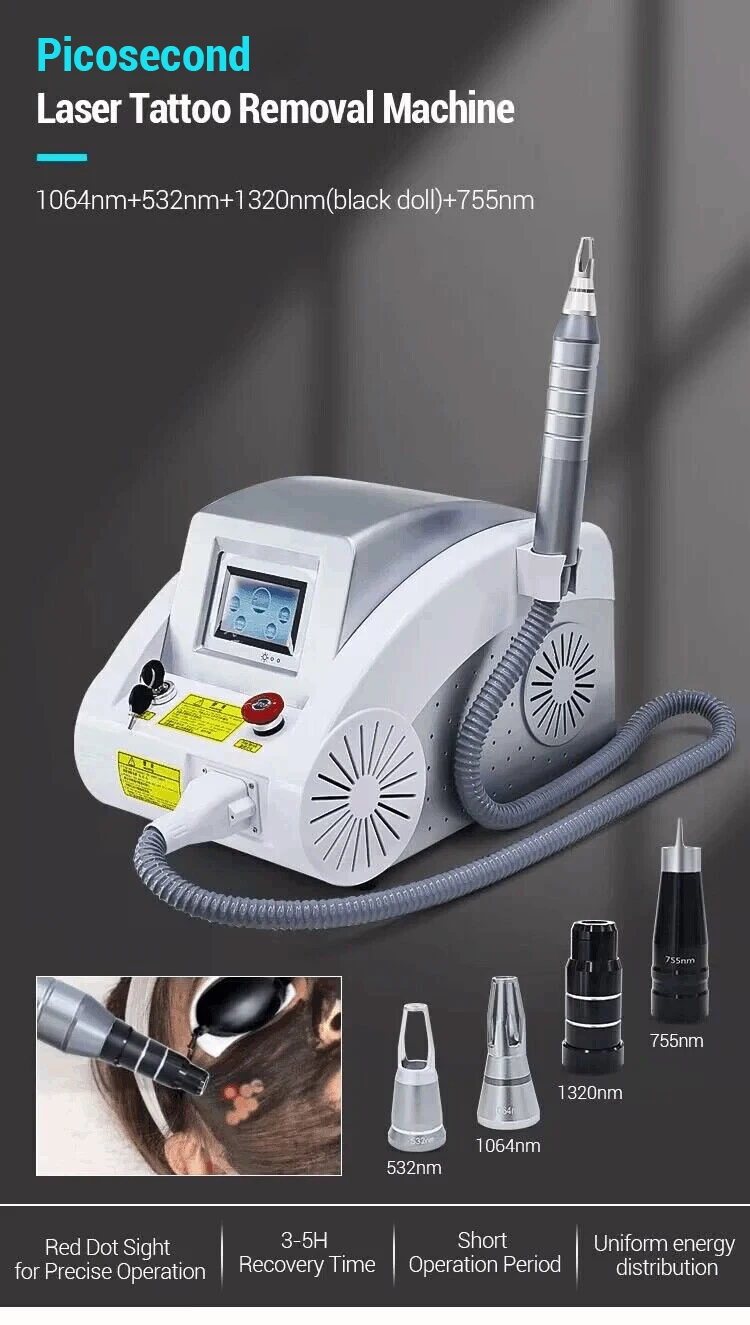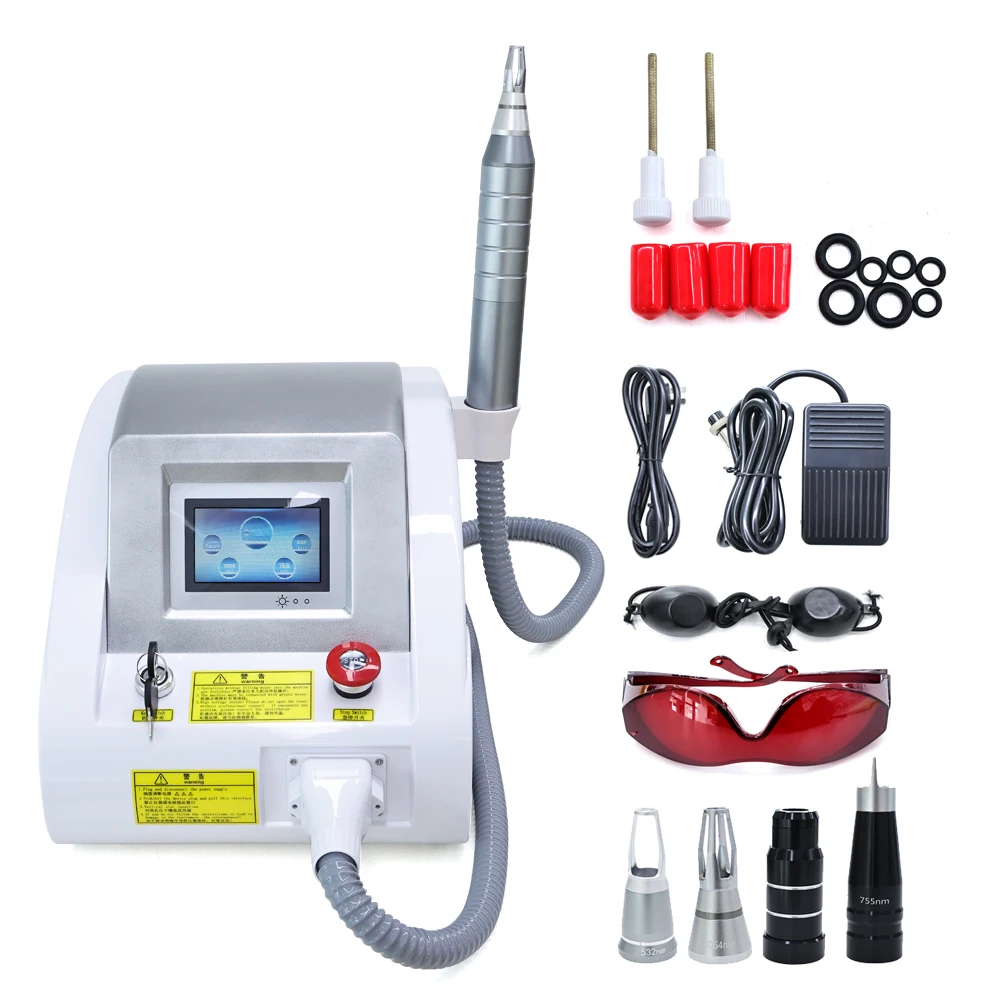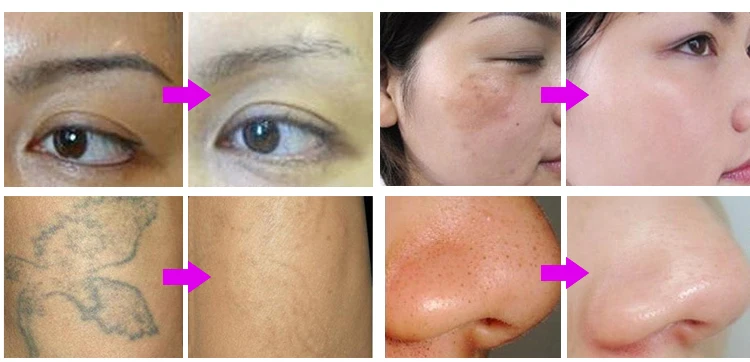




Q Switch Picosecond laser tattoo removal machine
Introduction to Q-Switch Picosecond Laser Tattoo Removal
What is Tattoo Removal?
Tattoo removal is a process aimed at eliminating unwanted tattoos from the skin. Historically, methods like dermabrasion, excision, and chemical peels were used, but the most effective and advanced method today is laser tattoo removal.
Evolution of Laser Tattoo Removal
Initially, tattoo removal was performed using Q-Switch nanosecond lasers, which use very short bursts of energy to break up the tattoo ink. The development of picosecond lasers has significantly improved the process, offering more effective results with fewer treatments and reduced side effects.
Understanding Laser Technology
Basics of Laser Operation
A laser (Light Amplification by Stimulated Emission of Radiation) produces a concentrated beam of light that can be targeted at specific tissues or pigments. The wavelength of the laser determines its effectiveness for different colors of ink.
Q-Switch Lasers
Q-Switch lasers are named for their ability to produce very short, high-energy pulses. These lasers are particularly effective in tattoo removal because they can fragment ink particles into smaller pieces, which are then gradually eliminated by the body's natural processes.
Picosecond Lasers
Picosecond lasers are an advancement over nanosecond lasers. They deliver pulses of energy in picoseconds (trillionths of a second) rather than nanoseconds (billionths of a second). This results in even finer fragmentation of the ink particles and more efficient removal.
Technology of Q-Switch Picosecond Lasers
How Q-Switch Picosecond Lasers Work
Pulse Duration: The picosecond pulse duration allows for a higher peak power density and more precise targeting of the ink particles. This precision reduces the risk of damage to the surrounding skin.
Photoacoustic Effect: The laser light is absorbed by the tattoo ink, causing it to expand and shatter into smaller fragments due to a photoacoustic effect. These fragments are easier for the body to remove.
Multiple Wavelengths: Q-Switch Picosecond lasers often feature multiple wavelengths (e.g., 532 nm, 755 nm, 1064 nm) to target a range of ink colors effectively. Each wavelength is suited to different pigments, providing versatility in treating various tattoo colors.
Advantages Over Nanosecond Lasers
Enhanced Ink Fragmentation: Picosecond lasers can break down ink particles into smaller sizes than nanosecond lasers, improving the efficiency of the removal process.
Fewer Treatments Required: Due to the more effective fragmentation of ink particles, fewer sessions are typically needed for complete removal.
Reduced Risk of Hypopigmentation: The precise nature of picosecond lasers minimizes the risk of hypopigmentation (lightening of the skin) compared to traditional nanosecond lasers.
Reduced Side Effects: The shorter pulse duration and improved targeting reduce the risk of side effects such as scarring and changes in skin texture.
Applications and Procedure
Pre-Treatment Assessment
Before beginning tattoo removal, a thorough assessment of the tattoo and the skin is necessary. Factors like the type of ink used, the depth of ink penetration, the color of the ink, and the patient’s skin type influence the treatment plan.
The Tattoo Removal Procedure
Preparation: The area is cleansed, and a cooling gel may be applied to protect the skin and enhance comfort.
Laser Treatment: The Q-Switch Picosecond laser is applied to the tattoo. The patient may experience a sensation similar to the snapping of a rubber band. Depending on the size and complexity of the tattoo, the procedure may take from a few minutes to an hour.
Post-Treatment Care: After the session, the treated area is cooled, and ointment may be applied. Patients are usually advised to avoid direct sunlight and follow specific aftercare instructions to ensure proper healing.
Typical Treatment Schedule
Tattoo removal typically requires multiple sessions, spaced several weeks apart. The exact number of sessions depends on various factors, including the tattoo’s age, color, and size.
Advantages of Q-Switch Picosecond Laser Tattoo Removal
Effectiveness
Comprehensive Color Removal: The ability to target various ink colors with different wavelengths makes it highly effective for multi-colored tattoos.
Faster Results: Patients often see faster and more complete removal compared to traditional methods.
Safety
Minimized Skin Damage: The advanced technology reduces the risk of damage to the surrounding skin.
Fewer Complications: The precision of picosecond lasers minimizes complications such as scarring and changes in skin pigmentation.
Limitations and Challenges
Potential Side Effects
Hypopigmentation: Though less common, some patients may experience lightening of the skin where the tattoo was removed.
Blistering: Some patients may develop blisters, which typically heal without complications if properly managed.
Incomplete Removal: In some cases, complete removal of the tattoo may not be achievable, especially if the tattoo is deep or has been done with resistant inks.
Cost Considerations
Picosecond laser tattoo removal can be more expensive than traditional methods due to the advanced technology and fewer required sessions. However, the overall cost might be offset by the need for fewer treatments and the reduced risk of side effects.
Advances in Technology
New Developments
Enhanced Wavelengths: Ongoing research aims to improve the effectiveness of various wavelengths, making it possible to target even more types of ink.
Combination Treatments: Some clinics are experimenting with combining picosecond lasers with other technologies, such as fractional lasers or topical treatments, to improve outcomes.
Future Trends
Improved Safety Features: Innovations continue to focus on enhancing safety and reducing side effects.
Broader Applications: The principles of picosecond technology may be applied to other dermatological treatments beyond tattoo removal.
Conclusion
Q-Switch Picosecond laser tattoo removal represents a significant advancement in the field of tattoo removal. By offering enhanced effectiveness, reduced side effects, and faster results, picosecond lasers have become a preferred choice for many seeking to eliminate unwanted tattoos.
However, like any medical procedure, it is essential to consult with a qualified professional to determine the best approach for individual needs. Understanding the technology, potential risks, and benefits will help patients make informed decisions about their tattoo removal journey.


Product Parameter
| |
| Product name | Portable picosecond laser tattoo removal machine |
| Model number | EN109B |
| Technology | Picosecond laser |
| Laser wavelength | 1064nm+532nm+1320nm (black doll)+755nm |
| Laser energy | 50-2500MJ |
| Display | 4.3-inch touch screen |
| Frequency | 1-10Hz |
| Spot size | 2-10mm |
| Pulse width | 2000ps |
| Number of shots | 800,000 shots |
| Cooling system | Fan+ water+ condenser |
| Package size | 55*39*41cm |
| Package weight | 18kg |
Working Principle
The laser tattoo removal machine integrates a red dot sight, acting as a precise visual aid for targeting treatment areas. Equipped with 4 laser heads operating at 1064nm, 532nm, and 755nm, along with a black doll head, this machine offers exceptional versatility in treating a wide range of tattoo ink colors commonly found in eyebrow tattoos. Emitting intense energy bursts, the laser heads induce a photomechanical effect, creating shockwaves to fragment ink particles into microscopic fragments. The body's immune system gradually eliminates these fragmented ink particles, resulting in effective tattoo removal.
Product Structure


Product Features
1. 1064nm+532nm+1320nm(black doll)+755nm——offer exceptional versatility in addressing a wide range of tattoo ink colors
2. Red dot sight for precise operation——each pulse of the laser is directed exactly where it's needed, minimizing any potential overlap and optimizing the efficacy of the removal procedure
3. Honeycomb spot——reduce the risk of thermal damage to the surrounding skin
4.4ns short pulse width——break down pigment into smaller parts
5. 3 to 5 hours recovery time——minimize discomfort and downtime
6. Effective and high-efficiency—— 2 to 4 times treatment courses



Before and After







